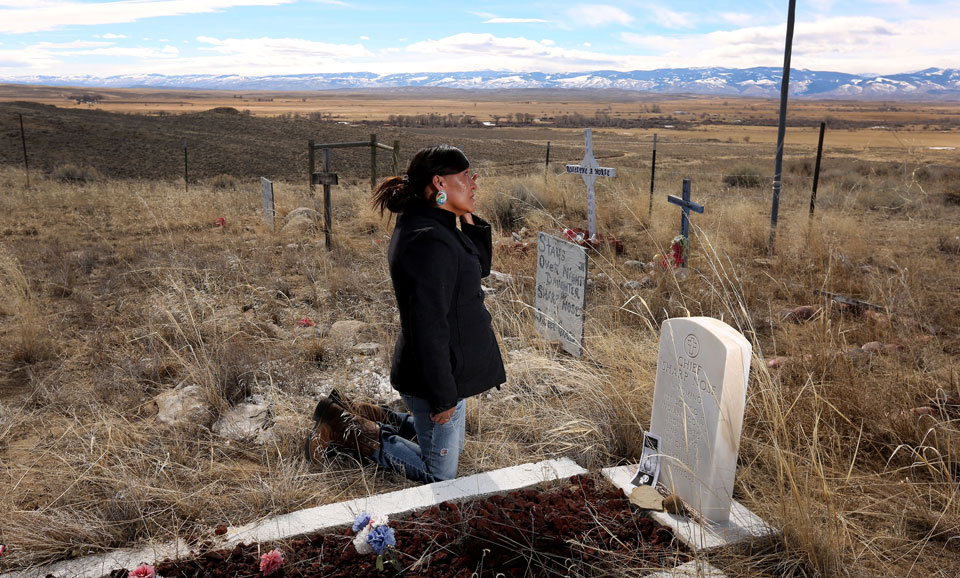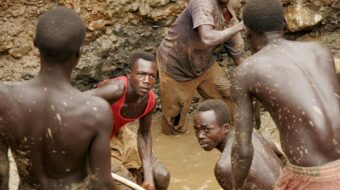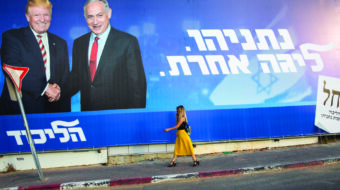
As you look over the mountains, plains, lakes, and streams of the Wind River Basin, you admire the beauty and majesty of this small piece of Wyoming. With a mixture of short grasslands, desert, and green forests, the natural beauty of the place makes it a wonder. For some, it might look like a barren place, but for those who live here and see this land untouched by the smog and bustle of the cities and industry, it is home.
This land is just a small part of a vast nation that once existed across the entire state of Wyoming, where great chiefs battled, where legends and tales came to life with the bluest sky, fluffiest clouds, and brightest stars. This is the Wind River Indian Reservation, home to two tribes, the Eastern Shoshone and Northern Aparaho, who were once bitter enemies but now cooperate to build and assist in governing their land together.
The Eastern Shoshone and Northern Arapaho seemed to always be at opposite ends of many conflicts up until the early 20th century. Many Eastern Shoshone assisted the United States Army in wars and conflicts against both Indigenous and nonindigenous nations and people, earning much praise and trust from the U.S. government. The Northern Arapaho, by contrast, were often on a different side in many conflicts and fiercely resisted U.S. expansion.

After the American Civil War, the Eastern Shoshone leader, Chief Washakie, known as a major strategist, warrior, and diplomat, negotiated a home for his people. At the same time, the Northern Arapaho leader, Chief Black Coal, following decades of resistance and fighting, began to cooperate with the United States. Both Chief Washakie and Chief Black Coal had the task of leading the transition from free-roaming life and armed conflict to friendship, alliance, and agrarian settlement.
Unfortunately, these leaders did not live long, but perhaps fortunately that meant they were spared from witnessing some of the evil and destruction that was coming to future generations of their people with the dawn of a new century.
Many new inventions, industries, movements, and ideas proliferated as the 19th century closed and the 20th began. Sadly, one of them was the stepped up effort by the U.S. government to forcefully assimilate Native American peoples into white-dominated society, and one of the chief instruments in this task was the residential boarding school for children.
The institutions and policies of the federal government were mobilized for the offensive, targeting the children of Native Americans and aiming to erase the culture and practices of their people. Instead of learning the traditions of their own societies, they were to be forced to become more “American.”
This process of assimilation took place both on and off the reservation, eventually amounting to cultural genocide and threatening the continued existence of the cultural heritage of all tribes. The phrase “Kill the Indian, save the man,” became the motto of the effort to “civilize” the Indian; it was coined by the founder of the first Indian boarding school, Richard Henry Pratt.
Pratt founded Carlisle Indian Industrial School in Pennsylvania, the first such residential school for Indigenous children to be founded in the U.S. The children from reservations were thrown into cattle cars. These descendants from the peoples of their land arrived bearing gifts for their teachers, but emerged scared and bruised, fearful of practicing their culture or even speaking their native tongues. Many never emerged at all, disappearing never to be seen again.
It is not uncommon for survivors to deal with post-traumatic stress disorder and to have suffered physical and sexual abuse. Stories were brought back to the reservation about the terrors of the schools by survivors, but the government simply told parents their children were receiving better education than they could get on the reservation.
In 2016, three bodies of Northern Arapaho children were discovered to be buried in the Carlisle cemetery next to the old boarding school, which is now used by the U.S. Army as a war college. Requests from the tribe to recover and transfer the bodies back to the Wind River Indian Reservation for proper burial were initially denied by the U.S. Army, which pointed to the fragile state of the bodies and the possibility they may be unrecoverable. The tribe pressed the Army and the base leadership not only for the remains of the children but also for tribal leaders and elders to be given a tour. Following tribal elders’ pleas, the Army finally opened the doors.
In 2017, Olivia Washington and Yufna Soldier Wolf, former Northern Arapaho tribal historic preservation officer, made the journey to reclaim a relative. Both Washington and Soldier Wolf said it was the tour of the school prison that really brought home the reality of what children endured there and the atrocities that continued unnoticed for decades.

“Having elders go through that tour was really difficult for them because they went to boarding school themselves,” said Soldier Wolf. But as upsetting and painful as it was, Soldier Wolf worked her whole life to go on this trip. When she was a girl, the federal government passed the Native American Graves Protection and Repatriation Act, or NAGPRA, and her tribal elders started talking about getting their ancestors back. The process started with a letter, and after moving up the military chain, the process of exhuming the bodies and returning them home began later on in 2017. The U.S. Army offered to pay for airfare for visitors and for the visitors to take the remains back to the reservation.
Unfortunately, the report of three bodies buried in the cemetery was incorrect. The military and tribe worked closely together unearthing records about the removal of many other bodies and their relocation to the present cemetery for the construction of a parking lot. These children were laid next to others who were murdered, died, or neglected. Records also indicated that although there were attempts to ensure all bodies were transferred, there could be more bodies in unknown locations.
This matches federal government reports revealed by Secretary of the Interior Deb Haaland of up to 200,000 Indigenous children laying in marked and unmarked graves, with causes of death ranging from homicide and murder to abuse, neglect, and manslaughter.

Of the three potential bodies discovered in 2016, only two could be exhumed, matched, and brought back. But further information unearthed from the government and the military states there may be more bodies of both Northern Arapaho and Eastern Shoshone children. Both Washington and Soldier Wolf were saddened that neither of the two bodies were relatives of theirs, but they were hopeful and grateful to start the process of reconciliation and to share their stories with their people and the world.
Back in Wyoming, people turned out in large numbers for the ceremonies bringing the children’s’ remains home.
“We treated it as a funeral because he and the other child were never given the traditional funerary rites that we give every one of our tribal members, and to show him we honor him, we love him. We still care for you as this little boy that’s coming back,” said Soldier Wolf.

The U.S. Government has never shared all the records it kept on the boarding schools or taken full responsibility for the promotion and use of these schools to attack Indigenous children. The government has not offered any type of hearings in Congress or bi-national commission between the United States and sovereign Indigenous nations to investigate the missing children. It has also failed to provide sufficient funds and support to find more missing children, but there are signs of reconciliation and truth emerging.
The recent Federal Indian Boarding School Initiative Investigative Report garnered mixed responses from Indigenous leaders, ranging from being characterized as “monumental” to being said to “leave key questions unanswered.”
It is the first report of its kind in which the U.S. government admits responsibility for the 150-plus years of atrocities committed against Indigenous children in the schools. But key unaddressed issues remain. Only volume one of the investigation’s findings has been released so far, and subsequent reporting may provide more answers.
The Wind River Tribal Business Councils work to this day on bringing all their people home and addressing the mistakes of the past and bringing them to the public. The recent dicsoveries of hundreds, or even thousands, of buried children in Canada’s Residential Schools has revived the conversation on boarding schools in the U.S.. The tribes offer programs and events centered on those who still have relatives missing along with sharing stories and information about the boarding school era.
For this country, we must address the mistakes and wrongs of the past against everyone in this land. The walk down the road to healing has started, but there is still a long way to go toward reconciliation.

MOST POPULAR TODAY

High Court essentially bans demonstrations, freedom of assembly in Deep South

U.S. imperialism’s ‘ironclad’ support for Israel increases fascist danger at home

UN warns that Israel is still blocking humanitarian aid to Gaza

Resource wars rage in eastern Congo, but U.S. capitalism only sees investment opportunity







Comments